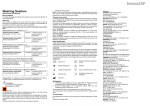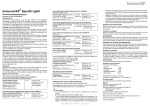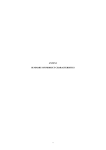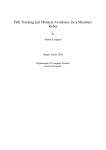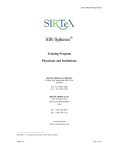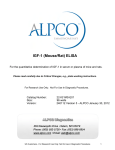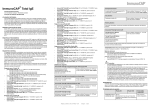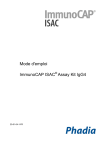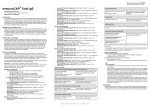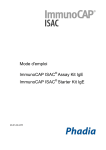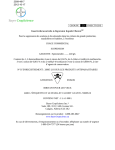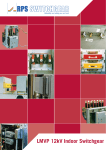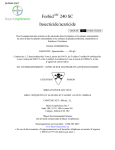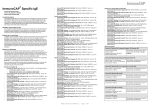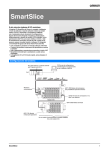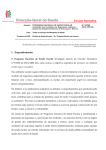Download ImmunoCAP ECP Conjugate 50
Transcript
® ImmunoCAP ECP Conjugate 50 Fluoroenzymeimmunoassay Directions for Use 52-5239-EN/07 INTENDED USE ImmunoCAP ECP is an in vitro test system for the quantitative measurement of Eosinophil Cationic Protein (ECP) in human serum. ImmunoCAP ECP Conjugate 50 is intended to be used with the instrument Phadia 250 and Phadia 1000. SUMMARY AND EXPLANATION OF THE TEST It is known that eosinophilia is associated with a variety of inflammatory disorders including allergic disease. Asthma is such a disease where primed and activated eosinophils are a common finding. In such diseases eosinophils and their toxic products are seen in tissue specimens from inflammation foci e.g. in asthma (1). The cells and their granule products seem to be major causes of the tissue destruction, e.g. shedding of epithelial cells in the airways (2,3,4). The pathophysiological changes seen in the asthmatic lung leads to hyperreactivity. The grade of inflammation may be identified by the presence of activated eosinophils in the peripheral blood. These cells have the propensity to release their granula constituents during the in vitro clotting process (5). This release is enhanced by temperature increase. Determination of released ECP may be one way to monitor conditions involving eosinophil activation. Inflammatory conditions like acute asthma are treated by anti-inflammatory drugs such as corticosteroids (6). The decline of inflammation, reflected by the released ECP, may be of value in monitoring the effect of therapy. ECP levels have been found elevated in other clinical conditions connected with activated eosinophils like atopic dermatitis (7), certain infections (8), autoimmune conditions in the joints (9), gut (10) and in some parasitic diseases (11). PRINCIPLE OF THE PROCEDURE Anti-ECP, covalently coupled to ImmunoCAP, reacts with the ECP in the patient sample. After washing, enzyme labelled antibodies against ECP are added to form a complex. After incubation, unbound enzyme-anti-ECP is washed away and the bound complex is then incubated with a developing agent. After stopping the reaction, the fluorescence of the eluate is measured. To evaluate the test results, the response for the patient samples are transformed to concentrations with the use of a calibration curve. REAGENTS for Phadia 250 and Phadia 1000 Reagents are packaged in separate units, each purchased separately. The two digit suffix (-01) on the article number may vary between countries. All units are required to perform an assay, though, calibrators are not required for additional assays while the stored curve is valid. The expiration date and storage temperature for each of the units are stated on the outer label. Note! It is not recommended to pool any reagents. ImmunoCAP ECP Conjugate 50 (Art No 10-9321-01) (Fluoroenzymeimmunoassay for 2 x 50 determinations) ECP Conjugate 50 ß-Galactosidase-anti-ECP (mouse monoclonal antibodies) Approximately 1.5 µg/ml Sodium azide 0.05% Colour coded blue; 2.5 ml 2 vials Ready for use Store at 2 - 8 °C until expiration date Do not freeze! ImmunoCAP ECP Calibrator Strip (Art No 10-9345-01) (Reagents for one calibration curve) ECP Calibrator Strip (human ECP in buffer) Conc. 2; 5; 15; 100 and 200 µg/l Sodium azide 0.05%; 0.2 ml 1 strip The strip contains one calibration curve Ready for use Store at 2 - 8 °C until expiration date • • • ImmunoCAP ECP Curve Control Strip (Art No 10-9352-01) (Reagents for 6 x 1 Curve Controls) ECP Curve Control Strip (CC1) (human ECP in buffer) Sodium azide, 0.05%; 0.2 ml 1 strip The strip contains 6 CC1 Ready for use Store at 2 - 8 °C until expiration date • ImmunoCAP ECP Anti-ECP (Art No 14-4515-01) ImmunoCAP Anti-ECP (a-ECP) (mouse monoclonal antibodies) Preservative* <0.003% Carriers of 16 Ready for use ImmunoCAP Store at 2 - 8 °C until expiration date Washing Solution (Art No 10-9202-01) For information see separate Washing Solution Directions for Use. REAGENTS for Phadia 250 Development Solution (Art No 10-9441-01/Art No 10-9440-01) (Reagents for 6 x 200 determinations/Reagents for 6 x 315 determinations) Development Solution 4-Methylumbelliferyl-ß-D-galactoside 0.01% Preservative* <0.0010%; 11 ml/17 ml 6 bottles Ready for use Store at 2 - 8 °C until expiration date Do not freeze! Stop Solution (Art No 10-9442-01) (Reagents for 6 x 185 determinations) Stop Solution Sodium carbonate 4%, 119 ml 6 bottles Ready for use Store at 2 - 8 °C until expiration date REAGENTS for Phadia 1000 Development Solution (Art No 10-9439-01/Art No 10-9314-01) (Reagents for 6 x 1200 determinations/Reagents for 6 x 2000 determinations) Development Solution 4-Methylumbelliferyl-ß-D-galactoside 0.01% Preservative* <0.0010%; 65 ml/112 ml 6 bottles Ready for use Store at 2 - 8 °C until expiration date Do not freeze! Stop Solution (Art No 34-2271-51) (Reagents for 1200 determinations) Stop Solution Sodium carbonate 4%; 850 ml 1 bottle Ready for use Store at 2 - 8 °C until expiration date *Preservative: Mixture of 5-chloro-2-methyl-4-isothiazolin-3-one [EC no. 247-500-7] and 2-methyl-2H-isothiazol-3-one [EC no. 220-239-6] (3:1). Published 2011-Jan-27 • Page 1(3) Precautions For in vitro diagnostic use. Not for internal or external use in humans or animals. Do not use reagents beyond their expiration dates. This kit contains reagents manufactured from human blood components. The source materials have been tested by immunoassay for hepatitis B surface antigen, for antibodies to HIV1, HIV2 and hepatitis C virus and found to be negative. Nevertheless, all recommended precautions for the handling of blood derivatives should be observed. Please refer to Human Health Service (HHS) Publication No. (CDC) 93-8395 or other local/national guidelines on laboratory safety procedures. Reagents containing >0.0015% mixture of 5-chloro-2-methyl-4-isothiazolin3-one [EC no. 247-500-7] and 2-methyl-2H-isothiazol-3-one [EC no. 220-239-6] (3:1) may cause sensitisation by skin contact. Avoid contact with skin. Wear suitable gloves. For more information see Safety Data Sheet. Reagents that contain sodium azide as a preservative must be handled with care. For more information see Safety Data Sheet. Handling of ImmunoCAP Carrier Keep the carrier closed to avoid evaporation of buffer. Do not leave the carrier open for more than 1 day at room temperature, otherwise, discard the first ImmunoCAP. Indication of instability Phadia 250 and Phadia 1000 software have built-in acceptance limits for the calibration curve and the curve controls. For more information see Phadia 250 User Manual and Phadia 1000 User Manual. INSTRUMENTS Phadia 250 and Phadia 1000 are continuous random access systems that perform all steps of the assay. For further information regarding handling of the systems see Phadia 250 User Manual and Phadia 1000 User Manual. SPECIMEN COLLECTION AND PREPARATION Parameters such as blood collection tube, coagulation time and temperature must be kept within specified limits, since they affect the concentration of released ECP in serum samples. The clotting represents the first incubation in the assay, in which the ECP measured is to be reproducibly released from the eosinophils which have been activated by the inflammation. 1. Collect blood by venipuncture using Terumo Venosafe Serum-Gel tubes. It is important that the tube is completely filled. Please, contact Phadia AB if another kind of serum collection tube than Venosafe is to be used. 2. After collection gently invert the tube several times. Do not shake or vortex the tube. 3. Release ECP by clotting for 60 to 120 minutes at room temperature 20-24 °C. The temperature must not vary more than ±1 °C between sampling occasions to give comparable results. 4. Centrifuge at 1000–1300xg for 10 minutes at room temperature. 5. Decant serum into a new tube. 6. Serum samples may be kept at room temperature for shipping purposes. Otherwise store at 2 °C to 8 °C if assayed within five days after collection or at –20 °C if assayed later. Note! Plasma and haemolyzed serum can not be used. For information on interfering substances see references (13,14). Preparation of Samples No dilution of sample is usually required, however, for determination of values higher than 200 µg ECP/l, samples can be diluted with: ImmunoCAP IgE/ECP/Tryptase Sample Diluent (10-9360-01) PROCEDURES For more information see Phadia 250 User Manual and Phadia 1000 User Manual. (b) On Board Stability Phadia 250 Phadia 1000 Calibrator/ CC -strip 28 days. If >3 days between usage, unload the strip and store in 2-8°C. Conjugate 4 days open in 2-8°C if bottles 7 days open in 2-8°C. are re-capped every night. Development solution 40h open in room temperature. 14 days open in 2-8°C. Can be used 5 times during shelf-life and be stored at room temperature for 8h on each occasion. Re-cap bottles every night. Stop solution 40h open in room temperature. 14 days capped in room Can be used 5 times during temperature. shelf-life and be stored at room temperature for 8h on each occasion. Re-cap bottles every night. Wash solution 7 days in room temperature. Discard every seventh day (prepared solution) and perform weekly maintenance according to respective instrument user manual. Diluent 7 days in room temperature. Re-cap bottles every night. ImmunoCAP Carrier Until expiration date. N/A Parameters of the procedure Volumes per determination: Sample Conjugate Development Solution Stop Solution 40 µl 50 µl 50 µl 600 µl The process time from entering the first sample is 1 hour and 45 minutes. Incubations are performed at 37°C by Phadia 250 and Phadia 1000. Procedural steps For more information see Phadia 250 User Manual and Phadia 1000 User Manual. Measuring Range Undiluted serum 2-200 µg/l. Quality control Record keeping for each assay: It is good laboratory practice to record the lot numbers of the components used, the dates when they were first opened and the remaining volumes. Control Specimens: Good laboratory practice requires that quality control specimens should be included in every run. Any material used should be assayed repeatedly to establish mean values and acceptable ranges. Controls available from Phadia AB for day to day quality control: One example of acute exacerbation of asthma During an acute attack of asthma the eosinophils become activated, resulting in elevated levels of ECP in serum. The figure shows ECP in serum and peak expiratory flow (PEF) in a 42 year old patient with an acute asthma. At admittance during an acute attack the patient has high levels of serum ECP. During therapy with corticosteroid the lung function increases to normal and the serum ECP levels decrease to normal, demonstrating that the inflammation is under control. ImmunoCAP ECP Control (10-9269-01) Proficiency Testing: An external quality assessment program (proficiency testing) is available from Phadia AB for quality assurance purposes (Quality Club): Quality Club ECP (10-9344-01) CALCULATION OF RESULTS All calculations are performed by the Phadia Operator Software. For more information see Phadia 250 User Manual and Phadia 1000 User Manual. LIMITATIONS OF THE PROCEDURE A definitive clinical diagnosis should not be based on the results of any single diagnostic method and should only be made by the physician after all clinical and laboratory findings have been evaluated. (a) EXPECTED VALUES (a) Comparison studies between Phadia 100 and Phadia 250 have been performed with 89 samples. Results for samples obtained with Phadia 100 and Phadia 250 show good agreement. (a) Comparison studies between Phadia 100 and Phadia 1000 have been performed with 89 samples. Results for samples obtained with Phadia 100 and Phadia 1000 show good agreement. (a) Comparison studies between Pharmacia CAP System ECP FEIA and Phadia 100 have been performed with 102 samples. Results for samples obtained with Pharmacia CAP System ECP FEIA and Phadia 100 show good agreement. (a) Results obtained for healthy subjects In a study with 95 apparently healthy adults, 44 males and 51 females (age 18-76) the following result was found: Geometric mean: 5.5 µg/l 90th and 95th percentile: 11.1 and 13.3 µg/l PERFORMANCE CHARACTERISTICS (a) Precision The following mean coefficients of variation have been obtained. Each sample has been assayed in 4 replicates on totally 18 different occasions using the same lot of reagents. The results have been obtained with Phadia 1000 using stored calibration curves. They are expected values for both Phadia 250 and Phadia 1000. Sample level µg/l Coefficients of variation (%) Within assay Between assay 2–5 6 4 5 – 100 4 4 100 – 200 4 5 (a) All samples were collected using Vacutainer SST tubes. The temperature during blood clotting was 20±1°C. Good laboratory practice dictates that each laboratory establishes its own range of values. Material Materials provided by Phadia AB: See under REAGENTS. Materials required but not provided by Phadia AB: • Measuring cylinder 1000 ml • Purified water Sensitivity The detection limit is <0.5 µg/l. (a) Specificity Cross reaction was tested with the following results: EPX <0.1% (a) Recovery Mean recovery is 87% for both Phadia 250 and Phadia 1000. WARRANTY The performance data presented here was obtained using the procedure indicated. Any change or modification in the procedure not recommended by Phadia AB may affect the results, in which event Phadia AB disclaims all warranties expressed, implied or statutory, including the implied warranty of merchantability and fitness for use. Phadia AB and its authorized distributors, in such event, shall not be liable for damages indirect or consequential. Calibration ImmunoCAP ECP Calibrator Strip is run in duplicate to obtain a full calibration curve. The curve can be stored. Use one ImmunoCAP ECP Curve Control Strip in duplicate to evaluate subsequent assays against the stored curve. For more information see Phadia 250 User Manual and Phadia 1000 User Manual. Reference material The ECP Calibrators are calibrated against pure ECP prepared according to Peterson, Jörnvall and Venge (12). Published 2011-Jan-27 Page 2(3) SYMBOLS USED Patents/Trademarks Batch Code In Vitro Diagnostic Medical Device Biological Risks Caution Temperature Limitation Contains Sufficient for <n> Tests Use By Consult Instructions for Use Manufacturer REFERENCES 1. Arm JP, Lee TM. The pathobiology of bronchial asthma. Adv Immunol 1992;51:323-82. 2. Filley WV, Holley KE, Kephart GM, Gleich GJ. Identification by immunofluorescence of eosinophil granule major basic protein in lung tissues of patients with bronchial asthma. Lancet 1982;2 (8288):11-16. 3. Venge P, Dahl R, Fredens K, Peterson CGB. Epithelial injury by human eosinophils. Am Rev Respir Dis 1988;138:54-7. 4. Bousquet J, Chanez P, Lacoste JY, Barnéon G, Ghavanian N, Enander I, et al. Eosinophilic inflammation in asthma. N Eng J Med 1990 ;323:1033-9. 5. Venge P. Serum measurements of eosinophil cationic protein (ECP) in bronchial asthma. Clin Exp Allergy 1993;23(Suppl 2):3-7. 6. Sheffer AL. Guidelines for the diagnosis and management of asthma. J Allergy Clin Immunol 1991;88(Suppl):425-534. 7. Kapp A, Czech W, Krutmann J, Schöpf E. Eosinophil cationic protein in sera of patients with atopic dermatitis. J Am Acad Dermatol 1991;24:555-8. 8. Paganelli R, Fanales-Belasio E, Scala E, Carmini D, Mezzaroma I, Pinter E, et al. Serum eosinophil cationic protein (ECP) in human immunodeficiency virus (HIV) infection. J Allergy Clin Immunol 1991;88:416-8. 9. Hällgren R, Bjelle A, Venge P. Eosinophil cationic protein in inflammatory synovial effusions as evidence of eosinophil involvement. Ann Rheum Dis 1984;43:556-62. 10. Hällgren R, Colombel JF, Dahl R, Fredens K, Kruse A, Jacobsen NO, et al. Neutrophil and eosinophil involvement of the small bowel in patients with Celiac disease and Crohn’s disease: Studies on the secretion rate and immunohistochemical localization of granulocyte granule constituents. Am J Med 1989;86:56-64. 11. Venge P, Dahl R, Fredens K, Hällgren R, Peterson C. Eosinophil cationic proteins (ECP and EPX) in health and disease. In: Yoshida T, Torisu M, eds. Immunobiology of the eosinophil. New York: Elsevier Biomedical, 1983;163-79. 12. Peterson CGB, Jörnvall H, Venge P. Purification and characterization of eosinophil cationic protein from normal human eosinophils. Eur J Haematol 1988;40:415-23. 13. Friedman RB, Young DS. Effects of Disease on Clinical Laboratory Tests. Second ed. AACC Press 1989;3-85 - 3-87. 14. Tryding N, Hansson P, Tufvesson C, Sjölin T, Sonntag O, editors. Drug Effects in Clinical Chemistry. Stockholm: Apoteksbolaget, 1992;357-8. The ImmunoCAP brand name has replaced the UniCAP brand name. The Phadia brand name is applied to instrument platforms and related system items. Notes (a) Studies performed at Phadia AB, Uppsala, Sweden. (b) Study performed at Åre Hospital, Sweden and University Hospital, Uppsala, Sweden. The following designations are trademarks belonging to Phadia AB: ImmunoCAP, Phadia, Quality Club. Venosafe is a trademark of Terumo. Addresses AUSTRIA Phadia Austria GmbH Floridsdorfer Hauptstrasse 1 A-1210 Vienna Tel: +43-1 270 2020 Fax: +43-1 270 202020 BELGIUM Phadia NV/SA Rue de la Fusée, 64 BE-1130 BRUSSELS Tel: +32-2 749 55 15 Fax: +32-2 749 55 23 BRAZIL Phadia Diagnósticos Ltda. Rua Luigi Galvani, 70-10° andar - conj. 101 Cidade Monções - São Paulo - SP Cep: 04575-020 Tel: +55-11 3345 5050 Fax: +55-11 3345 5060 CZECH REPUBLIC Phadia s.r.o. Ing. Milan Nemec Hostalkova 48 16900 PRAHA 6 Tel: +420 220 511 392 Fax.: +420 220 511 392 DENMARK Phadia ApS Gydevang 33 DK-3450 ALLERØD Tel: +45-70 23 33 06 Fax: +45-70 23 33 07 FINLAND Phadia Oy Rajatorpantie 41 c FIN-01640 VANTAA Tel: +358-9 8520 2560 Fax: +358-9 8520 2565 FRANCE Phadia S.A.S. BP 610 FR-78056 ST QUENTIN-EN-YVELINES CEDEX Tel: +33-1 61 37 34 30 Fax: +33-1 30 64 62 37 GERMANY Phadia GmbH Postfach 1050 DE-790 10 FREIBURG Tel: +49-761 47 805-0 Fax: +49-761 47805-338 GREAT BRITAIN Phadia Ltd Media House, Presley Way Crownhill, Milton Keynes MK8 0ES UK Tel: +44-1908 84 70 34 Fax: +44-1908 84 75 54 IRELAND Phadia Ltd. (Irish Branch) Beaghbeg, Carrigallen LEITRIM Tel: +44 1908 84 70 34 Fax: +44 1908 84 75 54 ITALY Phadia S.r.l. Via Libero Temolo, 4 IT-201 26 MILANO Tel: +39-0264 163 411 Fax: +39-0264 163 415 JAPAN Phadia K.K. Tokyo Opera City Tower 3-20-2, Nishi-shinjuku, Shinjuku-ku TOKYO JP-163-1431 Tel: +81-3 5365 83 32 Fax: +81-3 5365 83 36 KOREA Phadia Korea Co. LTD., 20 Fl, IT Mirea Tower 60-21, Gasan-dong Geumcheon-gu Seoul 153-801 Tel: +82-2-2027-5400 Fax: +82-2-2027-5404 Published 2011-Jan-27 THE NETHERLANDS Phadia B.V. Postbus 696 NL-3430 AR NIEUWEGEIN Tel: +31-30 602 37 00 Fax: +31-30 602 37 09 NORWAY Phadia AS Postboks 4756, Nydalen NO-0421 OSLO Tel: +47-21 67 32 80 Fax: +47-21 67 32 81 PORTUGAL Phadia Sociedade Unipessoal Lda Lagoas Park - Edifício n°11 - Piso 0 PT-2740-270 PORTO SALVO Tel: +351-214 23 53 50 Fax: +351-214 21 60 36 SOUTH AFRICA Laboratory Specialities (PTY) A Phadia Company P.O Box 1259 Ferndale 2160 Tel: +27 11 793 5337 Fax: +27 11 793 1064 SPAIN Phadia Spain SL Ctra. Rubí, 72-74 (Edifício Horizon) ES-08173 SANT CUGAT DEL VALLÉS (BARCELONA) Tel: +34-935 765 800 Fax: +34-935 765 820 SWEDEN Phadia AB, Marknadsbolag Sverige P O Box 6460 SE-751 37 UPPSALA Tel: +46-18 16 50 00 Fax: +46-18 16 63 24 SWITZERLAND Phadia AG Sennweidstrasse 46 CH-6312 STEINHAUSEN Tel: +41-43 343 40 50 Fax: +41-43 343 40 51 TAIWAN Phadia Taiwan Inc. 8F,-1, No. 147, Sec. 2, Jianguo N. Rd. TAIPEI 104 Taiwan R.O.C. Tel: +886-2 2516 0925 Fax: +886-2-2509 9756 USA Phadia US Inc. 4169 Commercial Avenue Portage, Michigan 49002 Tel: +1 800-346-4364 (Toll Free) Fax: +1 269 492-7541 OTHER COUNTRIES Phadia AB, Distributor Sales P O Box 6460, SE-751 37 UPPSALA Tel: +46 18 16 56 16 Fax: +46 18 16 63 65 Issued May 2006. Revised August 2010. © Phadia AB, Uppsala, Sweden. Manufactured by Phadia AB, P O Box 6460, SE-751 37 Uppsala, Sweden Tel: +46 18 16 50 00 Fax: +46 18 14 03 58 Page 3(3)



